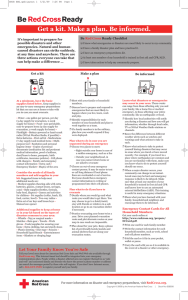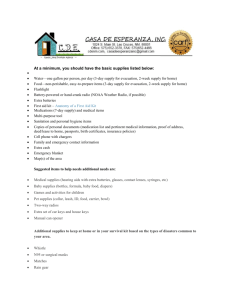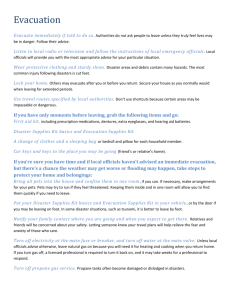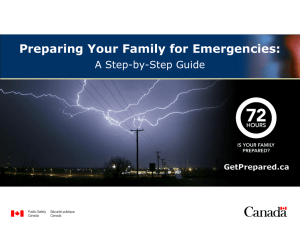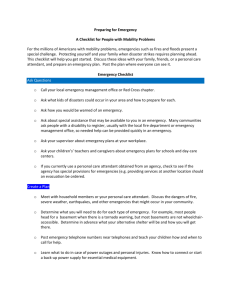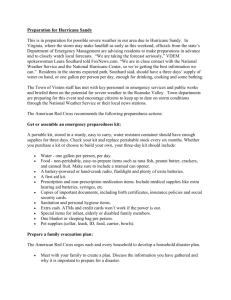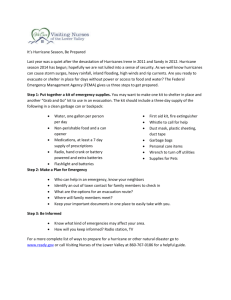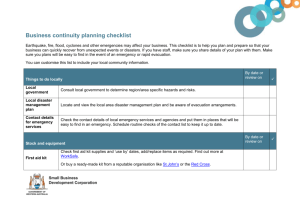Emergency Contact Cards for All Household Members
advertisement
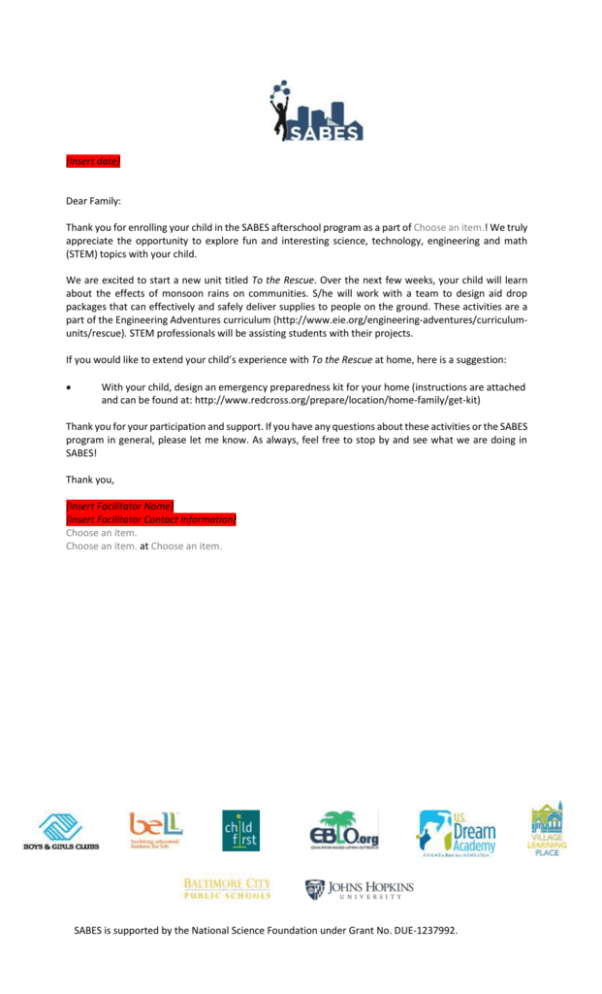
[Insert date] Dear Family: Thank you for enrolling your child in the SABES afterschool program as a part of Choose an item.! We truly appreciate the opportunity to explore fun and interesting science, technology, engineering and math (STEM) topics with your child. We are excited to start a new unit titled To the Rescue. Over the next few weeks, your child will learn about the effects of monsoon rains on communities. S/he will work with a team to design aid drop packages that can effectively and safely deliver supplies to people on the ground. These activities are a part of the Engineering Adventures curriculum (http://www.eie.org/engineering-adventures/curriculumunits/rescue). STEM professionals will be assisting students with their projects. If you would like to extend your child’s experience with To the Rescue at home, here is a suggestion: With your child, design an emergency preparedness kit for your home (instructions are attached and can be found at: http://www.redcross.org/prepare/location/home-family/get-kit) Thank you for your participation and support. If you have any questions about these activities or the SABES program in general, please let me know. As always, feel free to stop by and see what we are doing in SABES! Thank you, [Insert Facilitator Name] [Insert Facilitator Contact Information] Choose an item. Choose an item. at Choose an item. SABES is supported by the National Science Foundation under Grant No. DUE-1237992. Be Red Cross Ready Get a kit. Make a plan. Be informed It’s important to prepare for possible disasters and other emergencies. Natural and human-caused disasters can strike suddenly, at any time and anywhere. There are three actions everyone can take that can help make a difference … Be Red Cross Ready Checklist ▪ I know what emergencies or disasters are most likely to occur in my community. ▪ I have a family disaster plan and have practiced it. ▪ I have an emergency preparedness kit. ▪ At least one member of my household is trained in first aid and CPR/AED. ▪ I have taken action to help my community prepare. Get a kit At a minimum, have the basic supplies listed below. Keep supplies in an easy-to-carry emergency preparedness kit that you can use at home or take with you in case you must evacuate. • Water—one gallon per person, per day (3day supply for evacuation, 2-week supply for home) • Food—non-perishable, easy-toprepare items (3-day supply for evacuation, 2-week supply for home) • Flashlight • Battery-powered or handcrank radio (NOAA Weather Radio, if possible) • Extra batteries • First aid kit • Medications (7-day supply) and medical items • Multipurpose tool • Sanitation and personal hygiene items • Copies of personal documents (medication list and pertinent medical information, proof of address, deed/lease to home, passports, birth certificates, insurance policies) • Cell phone with chargers • Family and emergency contact information • Extra cash • Emergency blanket • Map(s) of the area Consider the needs of all family members and add supplies to your kit. Suggested items to help meet additional needs are: • Medical supplies (hearing aids with extra batteries, glasses, contact lenses, syringes, cane) • Baby supplies (bottles, formula, baby food, diapers) • Games and activities for children • Pet supplies (collar, leash, ID, food, carrier, bowl) • Two-way radios • Extra set of car keys and house keys • Manual can opener Additional supplies to keep at home or in your kit based on the types of disasters common to your area: • Whistle • N95 or surgical masks • Matches • Rain gear • Towels • Work gloves • Tools/supplies for securing your home • Extra clothing, hat and sturdy shoes • Plastic sheeting • Duct tape • Scissors • Household liquid bleach • Entertainment items • Blankets or sleeping bags Make a Plan Be informed Learn what disasters or emergencies may occur in your area. These events can range from those affecting only you and your family, like a home fire or medical emergency, to those affecting your entire community, like an earthquake or flood. Identify how local authorities will notify you during a disaster and how you will get information, whether through local radio, TV or NOAA Weather Radio stations or channels. Know the difference between different weather alerts such as watches and warnings and what actions to take in each. Know what actions to take to protect yourself during disasters that may occur in areas where you travel or have moved recently. For example, if you travel to a place where earthquakes are common and you are not familiar with them, make sure you know what to do to protect yourself should one occur. When a major disaster occurs, your community can change in an instant. Loved ones may be hurt and emergency response is likely to be delayed. Make sure that at least one member of your household is trained in first aid and CPR and knows how to use an automated external defibrillator (AED). This training is useful in many emergency situations. Share what you have learned with your family, household and neighbors and encourage them to be informed. Meet with your family or household members. Discuss how to prepare and respond to emergencies that are most likely to happen where you live, learn, work and play. Identify responsibilities for each member of your household and plan to work together as a team. If a family member is in the military, plan how you would respond if they were deployed. Plan what to do in case you are separated during an emergency Choose two places to meet: • Right outside your home in case of a sudden emergency, such as a fire • Outside your neighborhood, in case you cannot return home or are asked to evacuate Choose an out-of-area emergency contact person. It may be easier to text or call long distance if local phone lines are overloaded or out of service. Everyone should have emergency contact information in writing or programmed into their cell phones. Plan what to do if you have to evacuate Decide where you would go and what route you would take to get there. You may choose to go to a hotel/motel, stay with friends or relatives in a safe location or go to an evacuation shelter if necessary. Practice evacuating your home twice a year. Drive your planned evacuation route and plot alternate routes on your map in case roads are impassable. Plan ahead for your pets. Keep a phone list of pet-friendly hotels/motels and animal shelters that are along your evacuation routes. Emergency Contact Cards for All Household Members Let Your Family Know You’re Safe Tell your loved ones about the American Red Cross Safe and Well Web site available through RedCross.org. This Internet-based tool should be integrated into your emergency communications plan. People within a disaster-affected area can register themselves as “safe and well” and concerned family and friends who know the person’s phone number or address can search for messages posted by those who self-register. If you don’t have Internet access, call 1-866-GET-INFO to register yourself and your family. Get your cards online at http://www.redcross.org /prepare/ ECCard.pdf. Print one card for each family member. Write the contact information for each household member, such as work, school and cell phone numbers. Fold the card so it fits in your pocket, wallet or purse. Carry the card with you so it is available in the event of a disaster or other emergency For more information on disaster and emergency preparedness, visit RedCross.org. Copyright © 2009 by the American National Red Cross | Stock No. 658508
